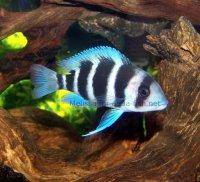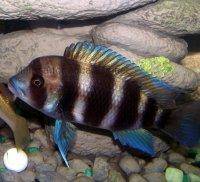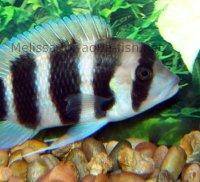Frontosa Cichlid Care Guide: Tank Setup, Diet, Breeding Tips & More
Quick links - Answers
Brief Description
This page provides all the essentials for keeping Frontosa cichlids in aquariums, covering everything from tank setup to different varieties of this species. If you don’t find the answers you need, feel free to use the form at the bottom to ask questions or share your experiences—we’d love to hear about your Frontosas!
Introduction
The Cyphotilapia frontosa gets its name from its distinctive features: "Cypho-" meaning "hump" in Greek, "-tilapia" from Tswana (a language spoken near Lake Ngami) meaning "fish," and "frontosa" from the Latin word Frontis meaning "with a big forehead." Often simply called frontosa, this recognizable cichlid is both sought after and expensive in the aquarium trade. The more common Burundi variant usually sells for $12 to $15 as juveniles, while rarer, vibrant blue varieties can cost around $250 due to their scarcity and breeding difficulty. Despite the price, these fish are a worthwhile investment, as they are not only visually appealing but also hardy, with a lifespan of up to 25 years.
Behaviour
Frontosas are strategic hunters that prefer efficiency over exertion. They typically hunt at dusk, taking advantage of prey that is just settling down, making them easier catches. In an aquarium, these carnivores will readily accept a variety of frozen and live foods along with prepared flakes and pellets. Frontosas thrive in large groups, similar to their natural colonies, but they need plenty of space due to their considerable size. Multiple males can coexist as long as there are ample hiding spots large enough for them to dart in and out of. Make sure rocks and caves are securely placed to prevent injuries during their sudden retreats. Despite being clumsy in quick movements, frontosas are much more graceful when swimming at a leisurely pace.
Water Conditions
Ensuring that frontosas feel safe and secure is crucial. They should be housed in a tank of at least 85 gallons (322 liters), with plenty of rocky caves for the males. While females appreciate having hiding spots, they don’t need them as much as males do. Frontosas prefer subdued lighting, as it simulates the dim conditions of their natural deep-water habitats. Bright lighting can cause them stress, making them feel exposed. Frontosas are sensitive to chemicals and pollutants, so regular partial water changes are essential. Maintain water temperatures between 75ºF and 79ºF (24ºC to 26ºC) with moderate to hard water and an alkaline pH ranging from 7.8 to 9.5. These fish enjoy digging in sandy substrates, though they will dig in gravel if available. Although frontosas might uproot plants, they are less likely to shred them compared to other cichlids.
Sexing
In frontosas, sexing is typically done by observing the hump on the head, which is generally more pronounced in males and smaller in females. However, this method is unreliable for sexing juveniles since the hump develops as both sexes mature. As they grow, males will typically become significantly larger and mature faster than females. Frontosas take several years to reach sexual maturity, with the exact timeline varying across different variations - some may take up to 3 years to fully mature.
Breeding
Frontosas are mouth-brooders that do not engage in the typical courting displays seen in other cichlids. There are no fin displays or elaborate dances by the male. Instead, breeding is straightforward: the male digs out and prepares a cave to entice the female. Once the female enters, she lays her eggs in the spot he has cleared. After the male fertilizes the eggs, the female gathers them into her mouth. Typically, she will produce around 50 large eggs, which she holds in her mouth. At this stage, it’s best to remove the male to prevent him from consuming the eggs. The female will brood the fry in her mouth for up to two months. Once released, the fry are relatively large, grow quickly, and readily accept a variety of foods.
When breeding frontosas, it’s crucial to keep different variations separate, as crossbreeding can lead to deformed or sterile offspring.
Variations
The true Cyphotilapia frontosa, distinguished by its seven stripes, originates exclusively from one region along Lake Tanganyika - Kigoma. Specimens previously labeled as C. frontosa from regions like Mpimbwe, Zaire, and Zambia are now reclassified as Cyphotilapia gibberosa. There are subtle yet technical differences that separate frontosa from gibberosa, such as the size and shape of the hump, scale count, and minor fin variations. With frontosa and gibberosa now clearly distinguished, the remaining task is to rename variations from Burundi, Kavala, and Karilani. Experts are likely to assign these new names in due time. Nevertheless, in the aquarium trade, “frontosa” will likely remain the common name used by most hobbyists for all variations of this species.
Although all varieties of frontosa might look similar, they actually come from different depths throughout Lake Tanganyika, ranging from as shallow as 15 feet (~4.57m) to as deep as 180 feet (~54.86m). Just like humans, these fish need to go through decompression phases when they ascend from extreme depths. Raising these fish too quickly can cause their swim bladder to expand excessively, potentially forcing their intestines out of their body.
The most popular varieties of Cyphotilapia are from Burundi, Kavala, and Karilani.
- The Burundi variant is the most common, featuring six stripes and a prominent hump that develops as it matures. While its coloration is less vivid than some other variations, it still has noticeable blue in its fins and a touch on its face.
- The Kavala variant, found at shallower depths of 15 to 20 feet (4.57 to 6.10 meters), displays a pearlescent white shade in its stripes. Its dorsal fin has a slight yellow tint, giving it a more iridescent appearance.
- The Karilani variant has blue coloring in its fins and face, similar to the Burundi version, but with additional blue on its body. Its dorsal fin features a goldish hue with a blue stripe along the edge.
Less common but still notable are the species from Kigoma, Mpimbwe, Zaire, and Zambia.
- The Kigoma is the only true C. frontosa, as it was the original type specimen described. This fish uniquely has seven stripes and a black mark below the eye. The true frontosa develops a large hump and features a blue face with a yellow sheen in the dorsal fin.
- The Mpimbwe C. gibberosa stands out for its unique behavior. This fish is not shy and has been known to eat directly from a person’s hand. It displays a bright blue color throughout much of its fins and body.
- The Zaire C. gibberosa is the most vibrantly colored. Its exquisite blue hue makes it the most sought-after variant, though it is more challenging to breed compared to other types. The nuchal hump on this fish is smaller, and it is found at the greatest depth, between 120 and 180 feet (36.58 and 54.86 meters).
- The Zambia C. gibberosa is the last variation to mention. It has less blue compared to the Zaire and Mpimbwe variants, but its striking black and white stripes and vivid blue face make it distinctive. Like the others, it is also quite difficult to breed.
Pictures
Resources
- Encyclopedia of Aquarium & Pond Fish by David Alderton
- Focus on Freshwater Aquarium Fish by Geoff Rogers and Nick Fletcher
- Aquarium Fishes of the World by Dr. Herbert R. Axelrod, Dr. Warren E. Burgess, Neal Pronek, Glen S. Axelrod and David E. Boruchowitz










